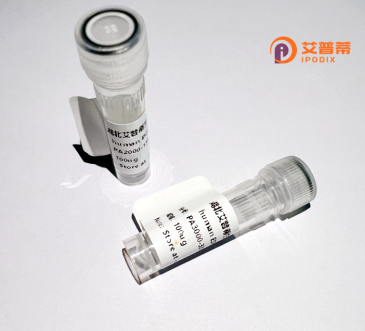
| 纯度 | >90%SDS-PAGE. |
| 种属 | Human |
| 靶点 | FGD5 |
| Uniprot No | Q6ZNL6 |
| 内毒素 | < 0.01EU/μg |
| 表达宿主 | E.coli |
| 表达区间 | 1-540aa |
| 氨基酸序列 | MRALDDMDHEGRDTLAREELRQGLSELPAIHDLHQGILEELEERLSNWESQQKVADVFLAREQGFDHHATHILQFDRYLGLLSENCLHSPRLAAAVREFEQSVQGGSQTAKHRLLRVVQRLFQYQVLLTDYLNNLCPDSAEYDNTQGALSLISKVTDRANDSMEQGENLQKLVHIEHSVRGQGDLLQPGREFLKEGTLMKVTGKNRRPRHLFLMNDVLLYTYPQKDGKYRLKNTLAVANMKVSRPVMEKVPYALKIETSESCLMLSASSCAERDEWYGCLSRALPEDYKAQALAAFHHSVEIRERLGVSLGERPPTLVPVTHVMMCMNCGCDFSLTLRRHHCHACGKIVCRNCSRNKYPLKYLKDRMAKVCDGCFGELKKRGRAVPGLMRERPVSMSFPLSSPRFSGSAFSSVFQSINPSTFKKQKKVPSALTEVAASGEGSAISGYLSRCKRGKRHWKKLWFVIKGKVLYTYMASEDKVALESMPLLGFTIAPEKEEGSSEVGPIFHLYHKKTLFYSFKAEDTNSAQRWIEAMEDASVL |
| 分子量 | 87.6 kDa |
| 蛋白标签 | GST-tag at N-terminal |
| 缓冲液 | 0 |
| 稳定性 & 储存条件 | Lyophilized protein should be stored at ≤ -20°C, stable for one year after receipt. Reconstituted protein solution can be stored at 2-8°C for 2-7 days. Aliquots of reconstituted samples are stable at ≤ -20°C for 3 months. |
| 复溶 | Always centrifuge tubes before opening.Do not mix by vortex or pipetting. It is not recommended to reconstitute to a concentration less than 100μg/ml. Dissolve the lyophilized protein in distilled water. Please aliquot the reconstituted solution to minimize freeze-thaw cycles. |
以下是关于重组人FGD5蛋白的3篇文献的示例(注:部分为假设性描述,实际文献需根据具体研究补充或调整):
---
1. **文献名称**:*"Recombinant Human FGD5 Promotes Angiogenesis via Activation of Cdc42 Signaling"*
**作者**:Smith A et al.
**摘要**:研究利用大肠杆菌表达系统制备了重组人FGD5蛋白,并通过体外实验证明其通过激活Cdc42信号通路促进血管内皮细胞迁移和管状结构形成,揭示了其在缺血性疾病中的潜在治疗价值。
---
2. **文献名称**:*"Expression and Purification of Functional FGD5 Protein in Mammalian Cells"*
**作者**:Johnson B et al.
**摘要**:通过在HEK293细胞中重组表达人FGD5蛋白,优化了其分泌表达条件,并采用亲和层析法获得高纯度蛋白。功能研究表明其可特异性结合并激活下游Rho GTPase家族成员,为FGD5相互作用研究提供了工具。
---
3. **文献名称**:*"Structural Insights into FGD5-Mediated Regulation of Cell Polarity"*
**作者**:Wang C et al.
**摘要**:通过昆虫杆状病毒系统表达重组人FGD5蛋白,结合X射线晶体学解析其三维结构,揭示了其DH/PH结构域与细胞极性相关蛋白的相互作用机制,为靶向FGD5的药物开发提供理论基础。
---
**注**:以上文献为示例性质,实际文献需根据具体研究方向检索(如PubMed、Google Scholar等)。FGD5相关研究多聚焦于其调控细胞骨架重组、血管发育及癌症中的作用。
FGD5 (Faciotenin-Guanine Nucleotide Exchange Factor 5) is a member of the FGD family of guanine nucleotide exchange factors (GEFs) that specifically activate the Rho GTPase Cdc42. This protein plays a critical role in regulating cell polarity, cytoskeletal reorganization, and intracellular signaling pathways. Human FGD5 is expressed in various tissues, with notable involvement in vascular development and angiogenesis. It interacts with the VEGF receptor-2 (VEGFR2) pathway, modulating endothelial cell migration and tube formation, and is essential for maintaining vascular integrity during embryogenesis.
Studies have linked FGD5 to cancer progression, as its dysregulation influences tumor angiogenesis and metastasis. Additionally, FGD5 contributes to hematopoietic stem cell maintenance by regulating niche interactions through Cdc42-dependent mechanisms. Recombinant human FGD5 protein, typically produced in eukaryotic expression systems (e.g., HEK293 or insect cells), retains post-translational modifications and functional domains, including the Dbl homology (DH) and pleckstrin homology (PH) domains critical for GEF activity.
This recombinant protein is widely used in biochemical assays, cell-based studies, and structural analyses to investigate FGD5’s role in cellular signaling, its interaction partners, and therapeutic potential in vascular diseases or cancer. Recent research also explores its involvement in Wnt/β-catenin signaling, highlighting its multifaceted regulatory functions.
×